What happens if we only use 2 resistors in the figure. Why do we use capacitor if we have a DC source already? And whats the easy way to calculate capacitor capacitance for given R and Vin?
At the end of the day, this circuit forms a low pass filter. The corner frequency is: \$f_o = \dfrac{1}{2\pi RC}\$. The capacitors are there to help stabilize the virtual ground. Practically \$1-10\mu F\$ with \$R=10k\Omega\$ is a good place to start. If your virtual ground is noisy relative to the system ground, look at the spectral content, and adjust R and C values to minimize it.
If you don't use the capacitors and rely on the resistors, any variation in ground current will create a variation in the centre voltage of the two resistors and this will shift +V and -V up and down. They'll move together because Vin is a constant supply. It's basically ohms law - you draw more current through 1 resistor and it will drop more voltage and shift the offset from half-way.
If the undulations in the ground current are high enough frequency, capacitors can be chosen that minimize the shifting on +V and -V. This is because capacitors oppose the change in voltage and will supply the current (temporarily) without altering their terminal voltage very much.
Q = CV and therefore \$\dfrac{dQ}{dt}\$ = \$C\dfrac{dv}{dt}\$
Change in charge (\$\dfrac{dQ}{dt}\$) = current so \$I=C\dfrac{dv}{dt}\$
If C is larger the change in voltage (\$\dfrac{dv}{dt}\$) is smaller.
A better solution (favoured in op-amp circuits) is to dedicate an op-amp as a unity gain follower to keep the "centre" voltage constant - useful for up to +/- 20mA draw from the op-amp output but some op-amps will be able to supply +/-100mA or more whilst keeping the centre-point stable in voltage.
Footnote - you can get by with one capacitor if Vin is a good supply because it acts like a large capacitance across +V and -V but, if unsure about Vin then use 2 caps.